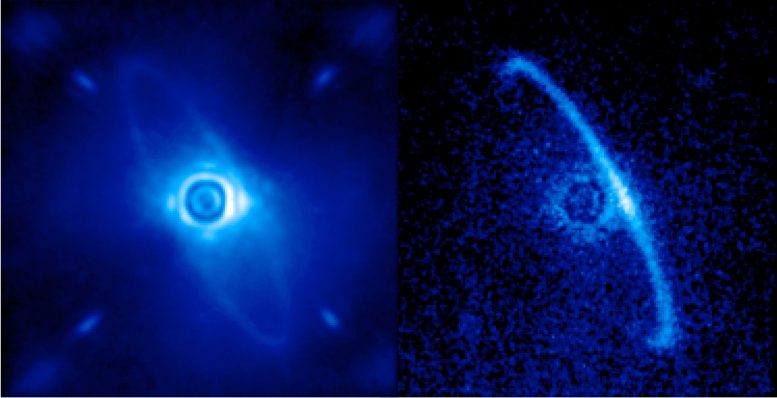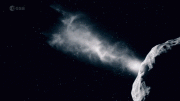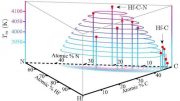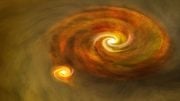
The Gemini Planet Imager’s first-light image of the light scattered by a disk of dust orbiting the young star HR4796A. This narrow ring is thought to be dust from asteroids or comets left behind by planet formation. Some scientists have theorized that the sharp edge of the ring is defined by an unseen planet. The image on the left shows normal light, including both the dust ring and the residual light from the central star scattered by turbulence in the Earth’s atmosphere. The right image shows only polarized light. The GPI’s Integral Field Spectrometer, which takes the pictures and records the spectra, was designed at UCLA. Credit: Processing by Marshall Perrin, Space Telescope Science Institute
The Gemini Planet Imager team will begin a large-scale survey, studying 600 young stars to see what planets orbit them.
After nearly a decade of development, construction and testing, the world’s most advanced instrument for directly imaging and analyzing planets outside our solar system is now collecting light from distant worlds.
The Gemini Planet Imager was designed and built to examine faint planets next to bright stars and probe their atmospheres. One of its major scientific components, the Integral Field Spectrometer, which takes the pictures and records the spectra, was built at UCLA’s Infrared Laboratory for Astrophysics, with UCLA astronomy professor James Larkin as lead investigator. UCLA graduate student Jeffrey Chilcote played a major role in the development and commissioning of the instrument and is completing his thesis with the first-light data.
The Infrared Laboratory for Astrophysics was founded by professor of physics and astronomy Ian S. McLean, who directs the lab. McLean and UCLA astronomy professor Michael Fitzgerald are co-investigators on the Integral Field Spectrometer, and McLean, Fitzgerald, and Larkin are all faculty members in the UCLA College of Letters and Science.
The Gemini Planet Imager, or GPI, is a powerful tool for studying dusty, planet-forming disks around young stars. It is the most advanced instrument of its kind to be deployed on one of the world’s biggest telescopes, the 8-meter Gemini South telescope in Chile.
“Even these early first-light images are almost a factor of 10 better than the previous generation of instruments,” said Bruce Macintosh of the Lawrence Livermore National Laboratory, who led the team that built the GPI and who in 1994 earned the first Ph.D. from UCLA’s Infrared Laboratory. “In one minute, we are seeing planets that used to take us an hour to detect.”
The UCLA-built Integral Field Spectrometer (IFS) detects infrared (heat) radiation from young planets in wide orbits around other stars, planets that are equivalent to giant planets in our own solar system not long after their formation. Every planet the GPI sees can be studied in detail.
“The IFS takes the chemical ‘fingerprint’ of the molecules in a planet’s atmosphere,” Larkin said. “From that, we can figure out its temperature and composition. The IFS is also crucial for removing starlight that can hide the planet’s signal even after the coronagraph and adaptive optics system.”
For the GPI’s first observations, the team targeted previously known planetary systems, including the well-known Beta Pictoris system some 63 light-years from our solar system. The instrument obtained the first-ever spectrum of the system’s very young planet Beta Pictoris b.
Astronomers also studied a faint ring of dust orbiting the very young star HR4796A, about 237 light-years away. With previous instruments, only the edges of this dust ring — which may be debris remaining from planet formation — could be seen. But with the GPI, astronomers could follow the entire circumference of the ring.
While the GPI was designed to look at distant planets, it can also observe objects in our solar system. GPI test images of Jupiter’s moon Europa, for example, allow scientists to map changes in the moon’s surface composition. The Europa images and others were released on January 7 at the annual meeting of the American Astronomical Society in Washington, D.C.
The GPI represents an “amazing technical achievement for the international team of scientists who conceived, designed and constructed the instrument, as well as a hallmark of the capabilities of the Gemini telescopes,” said Gary Schmidt, program officer at the National Science Foundation, which funded the project along with other countries of the Gemini Observatory partnership.
In 2014, the GPI team will begin a large-scale survey, studying 600 young stars to see what giant planets orbit them.
“Someday, there will be an instrument that will look a lot like GPI on a telescope in space,” Macintosh said. “And the images and spectra that will come out of that instrument will show a little blue dot that is another — Earth.”









Be the first to comment on "Gemini Planet Imager Will Begin Large-Scale Survey, Studying 600 Young Stars"